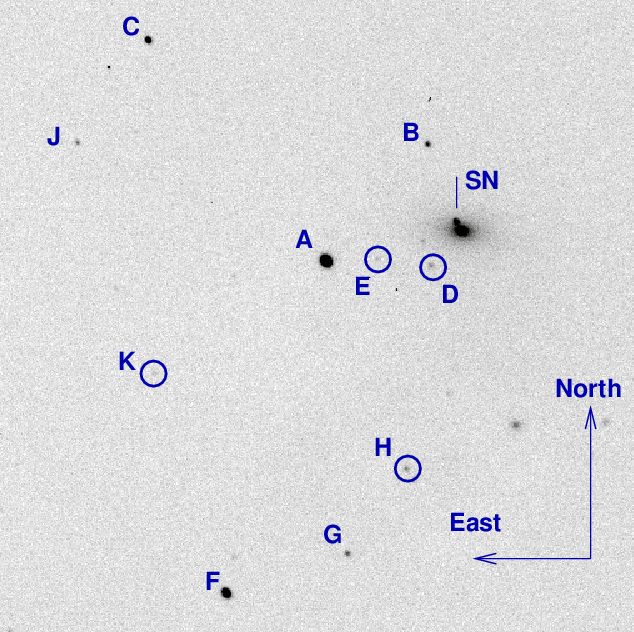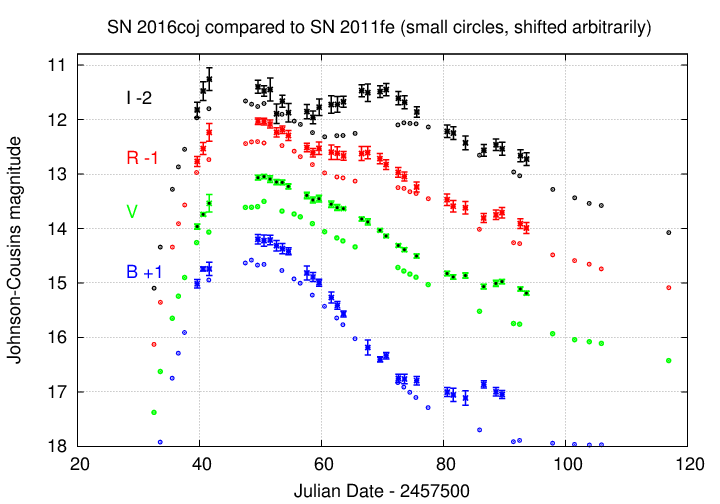
On the night of Jul 23/24, 2016, I observed SN 2016coj in NGC4125. I've stopped taking B-band images on a regular basis.
The main setup was:
Notes from the night
SN 2016coj is a Type Ia supernova in the relatively nearby galaxy NGC4125. It was discovered by the KAIT group some time before maximum light:
NGC 4125 RA = 12:08:05.7 Dec = +65:10:30 (J2000)

The AAVSO sequence team kindly provided photometry for stars near this object. You can see their full photometric sequence on their website. Below, I show only the members of that sequence which fall into my very small field of view -- taken from AAVSO sequence X16288FJI. Note that star "K" is so faint that I may not detect it clearly in B-band.
letter B sigB V sigV R sigR I sigI ------------------------------------------------------------------------ B 15.198 0.086 14.133 0.052 13.627 0.116 13.155 0.156 C 13.317 0.093 12.673 0.058 12.316 0.121 11.980 0.161 J 15.607 0.109 14.956 0.065 14.603 0.136 14.271 0.182 K 16.573 0.123 15.975 0.082 15.547 0.174 15.147 0.231 -------------------------------------------------------------------------
I used dark frames taken after all the SN 2016coj images.
I took sets of 9-15 images in each filter, guiding in all filters. I used longer guide exposure times in I. I discarded any trailed images.
I used focus settings based on relative positions measured for a bright star earlier. At a temperature of T = 27 C, I determined
As explained in the notes to Jun 14, 2016, I used the "rotsub" technique to remove the galaxy's light at the position of the SN.
On this night, I used "method 2", which means performing "rotsub" on each individual image, then combining all the resulting images in a passband to make a "master rotsub" image.
Using aperture photometry with a radius of 4 pixels (radius of 5.5 arcsec) I measured the instrumental magnitudes of a number of reference stars and the target. Following the procedures outlined by Kent Honeycutt's article on inhomogeneous ensemble photometry, I used all stars available in each image to define a reference frame, and measured each star against this frame. I used the interim reference magnitudes above plus color terms which I am currently revising -- so please treat these results as preliminary to convert the ensemble instrumental magnitudes to the standard Johnson-Cousins BVRI scale.
Note that in the graph below, I combine data calibrated with UCAC4 photometry (first few weeks) with recent data calibrated with AAVSO photometry. That's inconsistent, and I'll re-compute all magnitudes later. Note further that I use only 2 AAVSO stars (B and C) for calibration, for consistency with earlier measurements; I'll use additional stars in my final calculations.
filter mag mag_uncert Julian Date
SN V = 15.149 +/- 0.071 (ens 0.032 zp 0.063) 2457593.60856
SN R = 14.939 +/- 0.097 (ens 0.027 zp 0.093) 2457593.59071
SN I = 14.680 +/- 0.117 (ens 0.039 zp 0.110) 2457593.62544
Below is a preliminary light curve, based on RIT Observatory measurements. I also show measurements of SN 2011fe in M101, an ordinary type Ia supernova, shifted arbitrarily.

Last modified 07/24/2016 by MWR.